Jan 07, 2026
Jan 07, 2026
 In the ranks of those who have contributed substantially to architectural practice and discourse in South Asia is Charles Correa. Born in 1930 of Goan origin, Correa studied at the University of Michigan, and then the Massachusetts Institute of Technology, before establishing a practice in Bombay. Over the span of a career starting in the early 1950s to the present day, Correa has evolved a distinctive style of his own and has been a chief actor or major participant in various influential projects that shape and give definition to postcolonial South Asian architecture.
In the ranks of those who have contributed substantially to architectural practice and discourse in South Asia is Charles Correa. Born in 1930 of Goan origin, Correa studied at the University of Michigan, and then the Massachusetts Institute of Technology, before establishing a practice in Bombay. Over the span of a career starting in the early 1950s to the present day, Correa has evolved a distinctive style of his own and has been a chief actor or major participant in various influential projects that shape and give definition to postcolonial South Asian architecture. 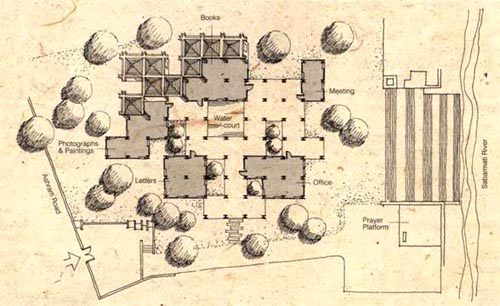
Gandhi Smarak Sangrahalaya, Ahmedabad. Plan. Notice massing of units.
Especially remarkable here is Correa’s use of natural light in conjunction with semi-open spaces to create tonal gradations in illumination and shadows. Correa acknowledges a strong debt to Le Corbusier, and this effect of the Frenchman’s influence is clearly visible here. The museum is solemn without being overbearing, is austere without appearing to make an effort to be so.

Gandhi Smarak Sangrahalaya, Ahmedabad.
View of courts.. Note use and blend of material and texture.
Continuing the same effort to interpret India’s vernacular architecture in a modern typology, the National Crafts Museum (1975-90) at Pragati Maidan, New Delhi, provides a forum to craftspeople nationwide to showcase their art – and the process of its creation! – to visitors, both resident and alien.
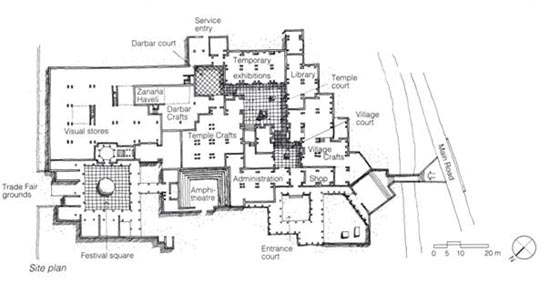
National Crafts Museum, New Delhi. Plan. Note linkage of spaces.
Its spaces massed together to recreate an Indian village, the Museum incorporates extensive use of vernacular material – stone, bamboo, brick, mud, thatch – and uses craftwork as both interior and exterior ornamentation. The result is once again a very impressive series of spaces that hold together as a unit, and display a high degree of functional efficiency. Correa demonstrates here a successful transition of the vernacular to the modern, as also how traditional architectural vocabulary need not be synonymous with ‘backward’.
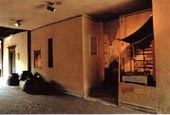
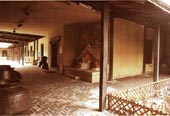
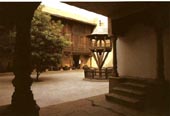
National Crafts Museum, New Delhi. Views with details of ornament and landscape elements.
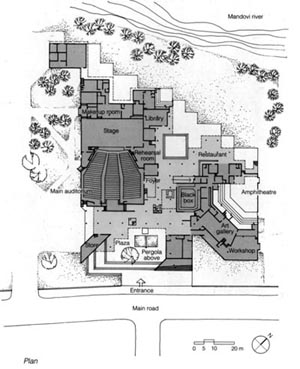 It is in his native Goa that Correa demonstrates a flair for an elegant use of colour and contrast, combined with intelligent space planning. In the Kala Akademi, Panaji, (1973-83) a centre for the performing arts, and the Cidade de Goa (1978-82), a luxury hotel, he plays with a hierarchy of spaces and terraces to create a spectacle of sorts in itself – and at both these sites an illusion of space and spectators is created by paintings complementing the architecture. At the Kala Akademi especially, Mario Miranda creates a skilful impression of people already present in the theatre. The Cidade de Goa – ‘City of Goa’ in Portuguese – is planned as a microcosm of a traditional city – complete with pedestrian streets, open space and marketplaces.
It is in his native Goa that Correa demonstrates a flair for an elegant use of colour and contrast, combined with intelligent space planning. In the Kala Akademi, Panaji, (1973-83) a centre for the performing arts, and the Cidade de Goa (1978-82), a luxury hotel, he plays with a hierarchy of spaces and terraces to create a spectacle of sorts in itself – and at both these sites an illusion of space and spectators is created by paintings complementing the architecture. At the Kala Akademi especially, Mario Miranda creates a skilful impression of people already present in the theatre. The Cidade de Goa – ‘City of Goa’ in Portuguese – is planned as a microcosm of a traditional city – complete with pedestrian streets, open space and marketplaces.
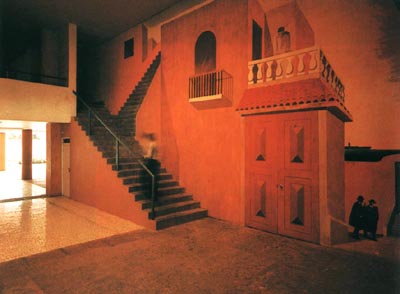
Kala Akademi, Panaji. Interior View.
The right side of this interior,
including the human figures at bottom right,
is actually a painting.
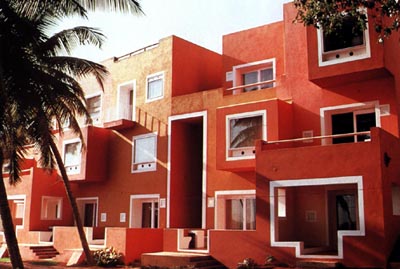
Cidade de Goa, Goa. External terraces and balconies.
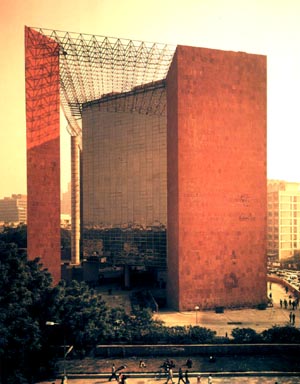 When it comes to monumental architecture, however, Correa has less success in blending the vernacular and the modern. The Jeevan Bharti (Life Insurance Corporation) (1975 – 86) headquarters at New Delhi towers over Connaught Place, its glass curtain walls reflecting the colonial-era buildings. Challenging and cocky, almost, in its aggressive use of sandstone cladding and the massive metal truss uniting its components, the Jeevan Bharti building disappoints in its details – the workmanship can be shoddy in parts, the fine elegance that characterises Correa’s smaller, earlier work is missing. This may be an inevitable consequence of success – lacking the time to devote to each project the attention it needs. For all this, the Jeevan Bharti building continues to be the object of debate and polemic, as much for its bold use of material as for the radical way in which it affects its urban surroundings.
When it comes to monumental architecture, however, Correa has less success in blending the vernacular and the modern. The Jeevan Bharti (Life Insurance Corporation) (1975 – 86) headquarters at New Delhi towers over Connaught Place, its glass curtain walls reflecting the colonial-era buildings. Challenging and cocky, almost, in its aggressive use of sandstone cladding and the massive metal truss uniting its components, the Jeevan Bharti building disappoints in its details – the workmanship can be shoddy in parts, the fine elegance that characterises Correa’s smaller, earlier work is missing. This may be an inevitable consequence of success – lacking the time to devote to each project the attention it needs. For all this, the Jeevan Bharti building continues to be the object of debate and polemic, as much for its bold use of material as for the radical way in which it affects its urban surroundings.
In his project for Navi Mumbai (New Bombay) (1964 - ), Correa argues for decongesting Bombay’s historic city centre, breaking the vicious cycle of inflated land-prices and accompanying high-rise growth, and limiting urban sprawl north of the city. His solution is to develop the land across from Bombay Harbour and increase road and rail links from the mainland to the new settlements, thus reducing old Bombay’s primacy as the sole business center.
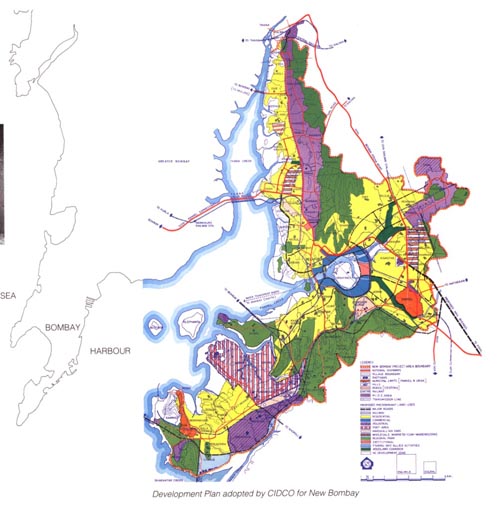
Navi Mumbai. New Bombay Redevelopment Plan.
Historic Bombay is to the left, new development to the right across the harbor.
18-Dec-2005
More by : Ashish Nangia

|
excellent project.. i want2 flow his work all time... |

|
Thank you so much!! |

|
thanks a lot ... |

|
nice building.... |

|
a very interesting read! |

|
simply excellent. |